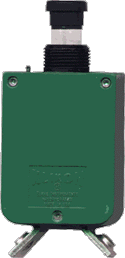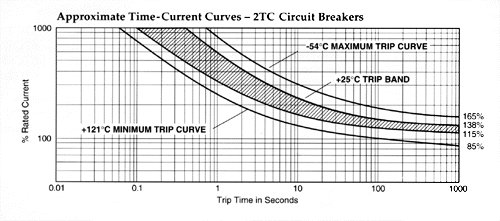The Deliberately Weak Link in the Electrical Chain
An
Aviation Circuit Breaker
Picture courtesy of Texas Instruments

Circuit breakers probably donít get the attention
they deserve. However,
several recent high-profile aircraft disasters have reminded us that
assumptions, misunderstandings or neglect of critical components, even
small ones, like circuit breakers, can have tragic consequences. The problem is even more acute as aircraft become
increasingly dependent on highly integrated electronic systems for
navigation, stability and control. Fly-by-wire
aircraft are obviously totally dependent on electricity for safe
operations.
Aircraft circuit breakers are designed to interrupt the flow of electrical current when specific conditions are reached. Those conditions of time and current, generate heat. Circuit breakers are designed to trip (open the circuit) before this heat damages either wiring or connectors. A specification might be for a breaker to trip under a massive short jolt (e.g. 10 times the rated load of the circuit-breaker for between .5 to 1.4 seconds) or a longer, less intense overload (e.g. twice the rated amperage for 3-130 seconds, depending on the type of circuit breaker). If the designed overload conditions are not exceeded, the circuit breaker will not trip. Some breakers are temperature sensitive and will trip earlier when warm than cold. See the attached Trip Curve.

Typical Trip Curve
Courtesy
of Texas Instruments
This highlights one of the limitations of circuit breaker design. The very tolerances that must be built into a circuit breaker to prevent nuisance tripping, such the high transient current that flows when a motor or component is started, means some glitches may not trip the breaker. Ticking faults and arc-tracking are examples. Ticking faults occur when tiny bolts of electricity intermittently arc from exposed wire conductor. On wires covered with aromatic polyimide wrap, installed in many aircraft built since 1970, this can burn the thin insulation, converting it into carbon, which is an excellent conductor Ė a nasty case of the insulator turning into the conductor! This can in turn lead to very short bursts (micro-seconds) of violent arcing where localized temperatures can reach extremely hot temperatures (well in excess of 1,000įC) capable of igniting nearby flammable material. Nevertheless, short, violent bursts of arc tracking will not necessarily trip breakers, which are comparatively slow-acting devices. Special arc fault circuit interruption devices, still a few years away from widespread use in aviation, are needed to deal this type of situation. If your aircraft has aromatic polyimide wire, there are very good reasons not to be in a rush to reset any tripped circuit breaker. The results could be catastrophic.
Circuit breakers are not intended to protect the
electrical equipment, which may have its own built-in protection or
mitigation system, but the wiring and connectors, which would otherwise
have no such protection. Aging,
vibration, excessive bending, improper installation, heat, moisture,
friction, wind blast, chemicals such as de-icing fluid, toilet fluid,
hydraulic fluid, oil and fuel can damage the insulation on the wire, if
not the conductor itself and any connectors.
In addition to disabling the circuit and any associated component,
this could also create a fire hazard, possibly in an area where it could
be impossible to use extinguishers and that could easily threaten the
safety of the flight. With
any in-flight fire, especially one in an inaccessible location or close to
critical components, an immediate landing becomes a very high priority.
Because such an option may not always be readily available (e.g. in
mountainous, arctic or oceanic areas) adequate circuit protection and a
good knowledge of what it can and cannot do, is essential.
Circuit breakers, are thermal-mechanical in nature.
Bimetallic elements, with one metal expanding more under heat than the
other, pop the breaker open. This
also enables them to be reset, albeit only after they have cooled down.
However, there are good reasons why it MAY NOT BE ADVISABLE to do
so, as we will soon see.
On many light aircraft, the circuit breakers are mounted along the bottom of the instrument panel. Many are flush fit and cannot be manually tripped or pulled. On larger aircraft, they are usually grouped in panels placed around the cockpit in locations were they would not be displacing vital instruments, switches or controls, and most can be manually tripped or pulled. Having them within sight and reach, although a necessity is both a blessing and a curse. A blessing because they can be seen and, IF NEED BE reset. A curse, because it is tempting to use them for a purpose they were never intended (i.e. as a switch) and to reset them when they should not be reset.
The electro-mechanical construction of a circuit
breaker was not designed for use as a switch, and using it for this
purpose causes premature wear and the risk of failure.
When a circuit breaker fails, it will take down a system, which may
be needed for the safe operation of the aircraft; or it will leave on line
a circuit that should be de-energized.
Both alternatives are unattractive, and both are capable of
inflicting catastrophic consequences.
It is wise to think twice before resetting any circuit breaker in
flight. It is telling you
something is wrong Ė that there has been a serious electrical event.
This danger signal must be interpreted with extreme caution.
The old rule of thumb to automatically allow one reset is not
prudent. Safety-conscious
airlines are now telling their crews not to reset any breakers unless they
are essential to safety and then to do so only once.
Wherever possible, this should be done only after consulting the
relevant resources (e.g. the Quick Reference Handbook, the MEL, Aircraft Flight Manual, Company
Operations Manual, and/or maintenance.)
This approach might suggest that the reset be delayed until the
service is needed. There is
no need to reset a landing gear circuit breaker that trips after take off
until one is committed to landing.
Unless your organization already has a comprehensive policy on circuit breakers, it is time that Flight Ops and Engineering/Maintenance develop one. Even if you have one, donít assume that everyone is aware of it, understands it and is using it. Better to be surprised by finding out now that they are not than to learn about it after a tragic event. Being at altitude with a deteriorating situation on your hands is no time to develop a good policy. In the meantime, logging any circuit breaker anomalies gives maintenance a much more accurate picture of the nature of the problem.
Circuit breakers: a willing friend, ready to save you from harmís way, provided you understand and respect their limitations.
Mike Murphy, former ATPL pilot and ex-TC executive, now chair of the Air Passenger Safety Group, thanks Mark Van Berkel formerly with Transport Canada Aircraft Services for his insights into this important topic, Texas Instruments (Klixon Circuit Breakers) for their generous permission to use the above graphics, and a group of his former colleagues for vigorous peer review of this article.
----------------------------------------------------------
Reader Feedback on This Article
I
just finished reading the [January 2001 Aviation Safety Letter] and the
article 'The Deliberately Weak Link...' It describes exactly a
recent experience to which I reacted properly but mainly by default (or
instincts). I wish I had the knowledge outlined in the article.
The
ASL is a most valuable resource and must read. Sometimes this kind of
knowledge used to come from experienced pilots engaged in 'hanger talk' when
I learned to fly. Now, I have no time. The ASL is a valuable,
authoritative resource on which I rely. I hope it continues. I usually do
not offer unsolicited compliments, but positive feedback is always meaningful.
Name Withheld by Request
I
have today received the ASL issue 1/2001, in which there is an excellent
article "...Weak Link in the Electrical Chain", p.12
although why it should come from "Air Passenger Safety group" is
peculiar. (There is quite a story to this! - ed.)
Former Military and Retired Airline Pilot
I found your article in the 1/2001 issue of the Aviation Safety Letter both interesting and relevant to the amateur-builder. On behalf of the RAA-Canada, I would like to ask permission to reprint your article in our magazine, the Recreational Flyer. Please forward by e-mail.
Senior Official of Respected Aviation Organization
Your papers on [aromatic polyimide wiring] and Circuit breakers are
excellent. Thank you for sending
them.
Former Airline Pilot - Australia
Your reports are very well
written, well researched and well documented.
Professional Engineer
Nice article on circuit breakers. I
didn't realize you had an electrical background.
Professional Engineer
Our company changed the
instructions re. the use of CB's last year. Basically
it changed to "keep your bloody hands off them". Considered a
bit of a pain by me and many of my colleagues, since resetting them/using
them as on-off switches is in some cases the only way for us to clear up a
problem in various cabin systems.
I now understand the validity of this "annoying" new
instruction. Which makes it a lot easier to comply with, instead of being
tempted to "give it a go anyway, we've always done it that way
before". Thank you.
Professional Pilot - responding to a vulgarized
version of this article, posted to the PPRUNE website.
WHAT ARE YOUR COMMENTS ON THIS
ARTICLE?
Some Useful Aircraft Wiring and Electrical System Links
IEEE Spectrum Online Magazine -Cover Story on Aircraft Wiring
Prognostics
for Wiring: Managing the Health of Aging Wiring Systems
Economic
Aircraft Wire Maintenance, Inspection & Repair: Performance
Implications
Survey
of Electrical Failures in Aircraft Mishaps
FAA Aging Non-Structural Systems Research
FAA Advisory Circular 25-16 on Electrical Fault and Fire Prevention and Protection
Letter from ALPA to FAA on Resetting Circuit Breakers and Aircraft Fire Ignition
Excerpt
from White House Report on Wiring
Dupont's
Statement on Polyimide Film Insulation
CADMUS
Briefing Note on Aromatic Polyimide Wire - Feb 1997
Different
Types
of Aircraft Wire
Chart showing General Purpose Wire in Transport Category Jet Aircraft
(see pages 11 and
12)
Arc Fault Circuit Interrupters